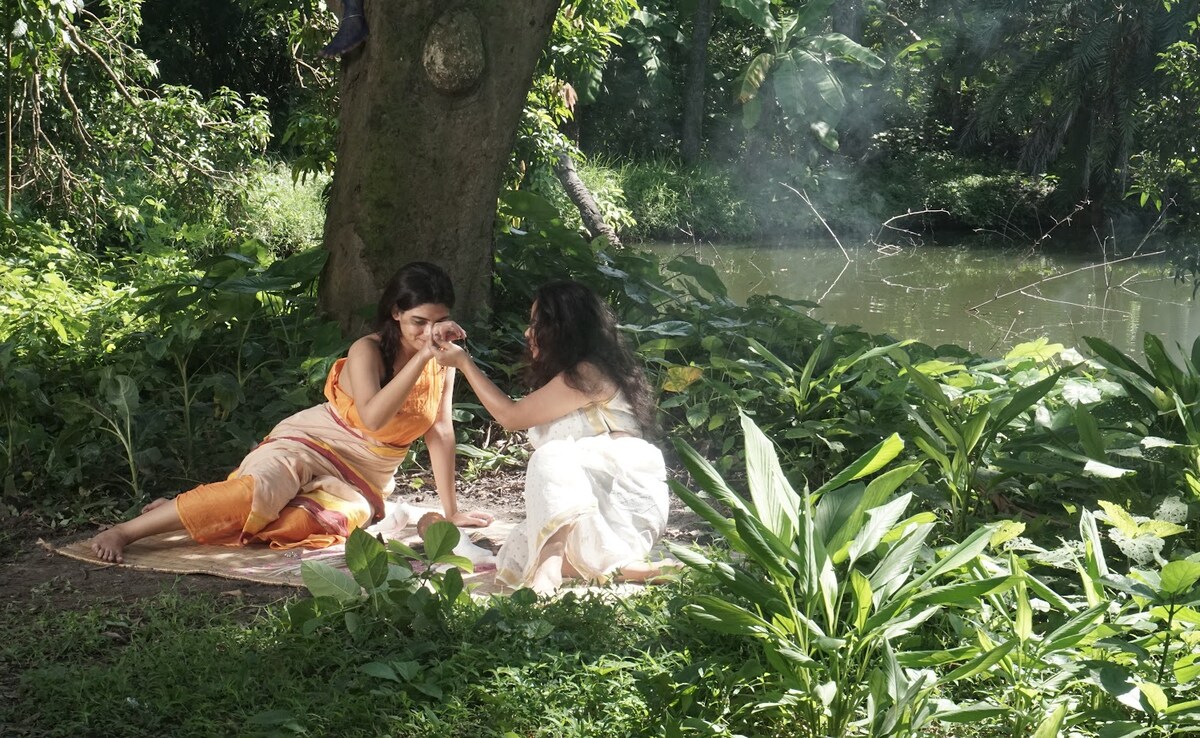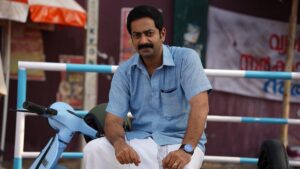A wonderful, if at times challenging, oddity

Since the silent era, the life of Rajasthani mystic-poet Meerabai has been brought to the big screen by many Indian filmmakers, notably Devaki Bose (1933), Ellis and Dungan (1947) and Gulzar (1979). They cast Durga Khote, MS Subbalakshmi and Hema Malini respectively as historical/literary figures whose works and teachings have lived on in the cultural landscape of India for over four centuries.
Calcutta-based filmmaker Anirban Dutt’s sophomore feature-length cinematic work, feelingWhich premiered at the 2024 International Film Festival Rotterdam on Tuesday, Mirabai is set in a love triangle involving the revered Lord Krishna and his mythological cowherd-lover Radha. The film adopts a singular approach of mapping a poet’s soul into otherworldly territory.
The Hindi language film is nothing like the earlier dramatized iterations of the Meerabai story. It sees him only through the prism of his bhakti-sikta poems – compositions that are an integral part of the literature of the bhakti movement of medieval Hinduism and are still sung and recited today.
The film uses visual means to capture Meera’s outpouring of love for Lord Krishna. feeling A magical, if sometimes challenging, oddity characterized by performative grace and musical range.
It’s a highly stylized, abstract performance piece that conventional cinema consumers may find confusing. But rather than undermining the film’s ability to communicate its essence to a discerning, patient viewer, the studied non-linear opacity solidifies the construction.
feeling Meera compiled many famous bhajans and rendered them in various Hindustani classical ragas reflecting the various states of mind of the princess-saint of Mewa. Desire and expectation, hope and despair, ecstasy and envy, faith and melancholy – an array of emotions and moods are expressed in poetry and song.
Lyrics, music, dance and repertoire of mudras (gestures) and restraint acting (Acting), the film guides the attentive audience into a consciousness that becomes increasingly receptive as the exercise unfolds at a deliberate pace and a gentle rhythm.
feeling It is a series of theatrical vignettes that explore the depth of Meera’s immense love for Lord Krishna and her belief that he is personified as Radha in the real world and in a different era. Earthly passion and ethereal adoration merge as Radha and Meera mate in a dreamscape filled with the hues of longing.
The mythic and historical intertwining of corpses, hands, fingers, and firmly dancing feet reveals a spectrum of sensations both porous and impenetrable. Radha is a superior but original figure from mythology; Meerabai is a mortal woman of historical origin who left her royal comforts and family ties and went on a quest for divinity.
Two women from across time-zones and domains of consciousness are bound by what they love and long for—spontaneous recompense from Krishna, who, for his part, subtly emerges from the realm of goodness to express emotions that can only be described purely. human position
Meera finds her reflection in Radha. Radha is irritated by jealousy and occasional frustration at Lord Krishna’s restless attention. The real and the perceptible merge in ways that are not always fully realized. They do not depend on verbal pronunciation. Sustained nonchalance only enhances the range of cinematic experience that the film provides.
Somewhat inspired by the depiction of Krishna and Radha’s love in Jayadeva’s Gita Govinda, feeling Kangra and Pahari miniatures return occasionally as a way to illuminate the Radha-Mira relationship with their devotional fervor. It is realized how unwavering devotion works and mingles with a kind of indomitable and elevated passion that often remains absent because divine means do not yield to temporal needs.
Dutt’s dialogue-less storytelling cuts through the mists of time, haptic dimensions and human-divine divides of love and passion. His actors – Aritra Sengupta (Meera), Ritvik Bhattacharya (Krishna) and Shamila Bhattacharya (Radha) – are like dolls in his hands. They surrender completely to the will of the director both as receptacles of complex ideas and as conduits of emotional direction.
Dutt gave ample demonstration of his uncompromising filmmaking style in his debut feature, Janhvi (2018). The film, about a woman dreaming and pining for an absent lover, largely uses non-verbal means. It draws a parallel between rivers and the centrality of women in human civilization as objects of love, respect, exploitation and deprivation.
feelinglike JanhviInherent in devices that originate from the palette of a visual artist who strives to look beyond the mundane in search of the sublime. The film is also inspired by the spirit of a photographer, who carefully considers each frame and its meaning.
Dutt, who produced this hyper-independent film himself, also did the costumes and art direction. He uses film cameras (directed by Soham Dey) and audio recording devices to fill the frames with body movements, hand and eye expressions, carefully chosen backdrops, recited voices (Srijan Chatterjee) and songs (film music composers Vaishali Sinha and Pt. do Ajay Chakraborty) and instrumental pieces that heighten the ambiguity of emotions anchored in spirituality.
Among the film’s rich array of sounds, the pronunciation of one or two words is less than perfect. Stray errors stick because they disrupt the sonic coherence that the film otherwise maintains over its 90-odd minutes. But the hitches are not so high or so bright as to irreparably damage the image.
feeling A labor of love whose steadfast commitment to an unbroken approach to image-making deserves applause. This is the kind of cinema that is possible only when a filmmaker is able to free himself from the lure of mass approval.



